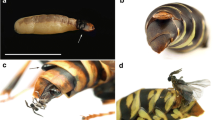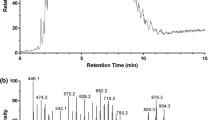Abstract
Extracts of the intact hairpencil glands and hairs from the hairpencil glands of males ofHeliothis virescens (F.) were analyzed by capillary gas chromatography (GC) and by GC-mass spectroscopy. These analyses indicated that hexadecanyl acetate (212.4 ng/male), hexadecanol (22.3 ng/male), (Z)-11-hexadecenyl acetate (3.5 ng/male), octadecanyl acetate (14.2 ng/male) octadecanol (7.5 ng/male), tetradecanoic acid (2.7 ng/male), hexadecanoic acid (22.3 ng/male), and octadecanoic acid (6.5 ng/male) were present in the extracts. These compounds also were found in volatiles released from the hairpencil glands. In addition, GC analysis using both polar and apolar capillary columns indicated that extracts of the glands and extracts of the hairs from the hairpencil glands contained small amounts of tetradecanyl acetate, (Z)-9-tetradecenyl acetate, tetradecanol, (Z)-7-hexadecenyl acetate, (Z)-9-hexadecenyl acetate, and (Z)-11-hexadecenol. No (Z)-9-tetradecenal was present. Studies indicated that titers of the compounds increased rapidly during the 36 hr after adult eclosion and then leveled off, being maintained at high levels until released when the glandular hairs were exposed. During exposure of the hair pencils substantial amounts of the compounds were released. In vivo application of 500 ng of suspensions of (Z)-11-hexadecenyl acetate, (E)-11-hexadecenyl acetate, (Z)-11-tetradecenyl acetate, or (E)-11-tetradecenyl acetate in dimethyl sulfoxide to the surface of the denuded hairpencil gland showed that biosynthesis proceeds to the alcohol via the acetate.
Similar content being viewed by others
References
Baker, T.C., Nishida, R., andRoelofs, W.L. 1981. Close-range attraction of female Oriental fruit moths to male hairpencils herbal essence.Science 214:1359–1361.
Birch, M.C. 1970. Structure and function of the pheromone-producing brush-organs in males ofPhologophora metriculosa (L.) (Lepidoptera: Noctuidae).Trans. R. Entomol. Soc. London 122:277–292.
Bjostad, L.B., andRoelofs, W.L. 1983. Sex pheromone biosynthesis inTrichoplusia ni: Key steps involve delta-11-desaturation and chain shortening.Science 220:1387–1389.
Bjostad, L.B., andRoelofs, W.L. 1984. Sex pheromone biosynthetic precursors inBombyx mori.Insect Biochem. 14:275–278.
Clearwater, J.R. 1972. Chemistry and function of pheromone produced by the male of the southern armyworm,Pseudaletia separata.J. Insect Physiol. 18:781–789.
Dahm, K.H., Meyer, D., Finn, W.E., Reinhold, V., andRöller, H. 1971. The olfactory and auditory mediated sex attraction inAchroia grisella (Fabr.).Naturwissenschaften 58:265–266.
Grant, G.G. 1978. Morphology of the presumed male pheromone glands in the forewings of tortricid and phycitid moths.Ann. Entomol. Soc. Am. 71:423–431.
Heath, R.R., Landolt, P.J., Leppla, N.C., andDueben, B.D. 1988. Identification of a maleproduced pheromone of Anticarsia gemmatalis (Hübner) (Lepidoptera: Noctuidae) attractive to conspecific males.J. Chem. Ecol. 14:1121–1130.
Hendricks, D.E. andShaver, T.N. 1975. Tobacco budworm: Male pheromone suppressed emission of sex pheromone by the female.Environ. Entomol. 4:555–558.
Hirai, K., Shorey, H.H., andGaston, L.K. 1978. Competition between courting male moths: Male-to-male inhibitory pheromone.Science 202:644–645.
Jacobson, M., Adler, V.E., andBaumhover, A.H. 1984. A male tobacco budworm pheromone inhibitory to courtship.J. Environ. Sci. Health A19:469–476.
Morrison, W.R., andSmith, L.M. 1964. Preparation of fatty acid methyl esters and dimethylacetals from lipids from boron fluoride-methanol.J. Lipid Res. 5:600–608.
Morse, D., andMeighen, E.A. 1984. Detection of pheromone biosynthetic and degradative enzymes in vitro.J. Biol. Chem. 259:475–480.
Morse, D., andMeighen, E.A. 1986. Pheromone biosynthesis and the role of functional groups in pheromone specificity.J. Chem. Ecol. 12:335–351.
Nielsen, M. 1979. Morphologie de la glande a pheromone sexuelle male dePhragatobia fuliginosa (Arctiidae).Arch. Biol. 90:161–176.
Pope, M.M., Gaston, L.K., andBaker, T.C. 1982. Composition quantitation, and periodicity of sex pheromone gland volatiles from individualHeliothis virescens females.J. Chem. Ecol. 8:1043–1055.
Shorey, H.H., McFarland, S.U., andGaston, L.K. 1968. Sex pheromones of noctuid moths. XIII. Changes in pheromone quantity as related to reproductive age and mating history in females of seven species of Noctuidae (Lepidoptera).Ann. Entomol. Soc. Am. 61:372–376.
Tamaki, Y. 1986. Sex pheromones, pp. 145–191,in G.A. Kerkut and L.I. Gilbert (eds.). Comprehensive Insect Physiology Biochemistry and Pharmacology, Vol. 9. Pergamon Press, New York.
Teal, P.E.A., andPhylogéne, B.P. 1980. The structure and function of the epidermal glands in the ovipositor ofEuxoa species (Lepidoptera: Noctuidae).Rev. Can. Biol. 39:233–240.
Teal, P.E.A., andTumlinson, J.H. 1986. Terminal steps in pheromone biosynthesis byHeliothis virescens andH. zea.J. Chem. Ecol. 12:353–365.
Teal, P.E.A., andTumlinson, J.H. 1987. The role of alcohols in pheromone biosynthesis by two noctuid moths that use acetate pheromone components.Arch. Insect Biochem. Physiol. 4:261–269.
Teal, P.E.A., McLaughlin, J.R., andTumlinson, J.H. 1981. Analysis of the reproductive behavior ofHeliothis virescens (F.) (Lepidoptera: Noctuidae) under laboratory conditions.Ann. Entomol. Soc. Am. 74:324–330.
Teal, P.E.A., Tumlinson, J.H., andHeath, R.R. 1986. Chemical and behavioral analysis of volatile sex pheromone components released by callingHeliothis virescens (F.) females (Lepidoptera: Noctuidae).J. Chem. Ecol. 12:107–126.
Tumlinson, J.H., andTeal, P.E.A. 1982. The sophisticated language of insect chemical communication.J. Ga. Entomol. Soc. 17:11–23.
Tumlinson, J.H., Heath, R.R., andTeal, P.E.A. 1982. Analysis of chemical communication systems of Lepidoptera, pp. 1–27,in B.A. Leonhardt and M. Beroza (eds.). Insect Pheromone Technology: Chemistry and Applications, American Chemical Society Symposium Series 190. American Chemical Society, Washington, D.C.
Vetter, R.S., andBaker, T.C. 1982. Behavioral responses ofHeliothis virescens in a sustained-flight tunnel to combinations of the seven compounds identified from the female sex pheromone gland.J. Chem. Ecol. 9:747–759.
Author information
Authors and Affiliations
Rights and permissions
About this article
Cite this article
Teal, P.E.A., Tumlinson, J.H. Isolation, identification, and biosynthesis of compounds produced by male hairpencil glands ofHeliothis virescens (F.) (Lepidoptera: Noctuidae). J Chem Ecol 15, 413–427 (1989). https://doi.org/10.1007/BF02027801
Received:
Accepted:
Issue Date:
DOI: https://doi.org/10.1007/BF02027801




